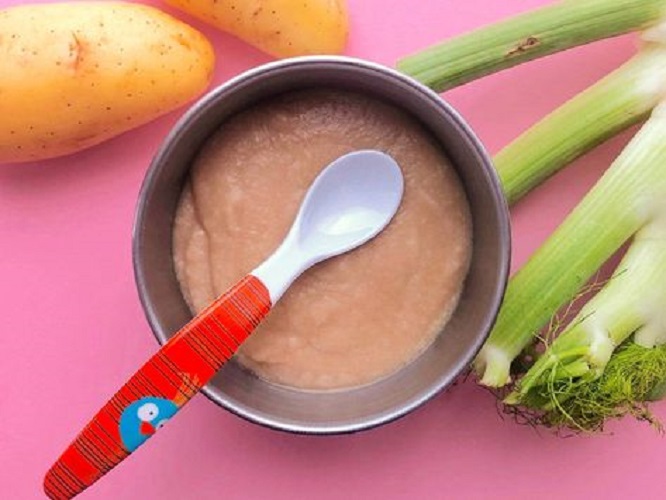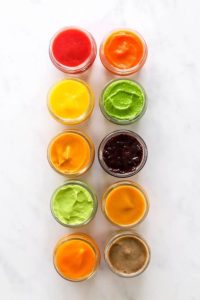Introducing solid foods is an exciting milestone in your baby’s development. It’s a time of exploration and discovery, with new tastes and textures to experience. But starting solids can also feel overwhelming for parents. When should you begin? What foods are best? This article focuses on introducing baby first vegetable puree.
Signs Your Baby Might Be Ready for Solids
Around 4 to 6 months old, babies typically show signs they’re developmentally ready for solid foods. Here are some cues to look for:
- Good head control: Your baby can hold their head steady when upright, with minimal support.
- Sitting with assistance: Your baby can sit with some support from you or in a highchair.
- Losing the tongue-thrust reflex: This reflex pushes food out of the tongue.
- Interest in food: Your baby watches you eat with interest and may reach for your food.
Choosing the Right Vegetables for Your Baby’s First Purees
Not all vegetables are created equal when it comes to first foods. Here are some factors to consider when selecting vegetables for your baby:
Mild flavor:
Opt for vegetables with a naturally sweet or bland taste, like sweet potatoes, carrots, peas, or avocado.
Smooth texture:
Choose vegetables that puree easily into a smooth consistency, like butternut squash or green beans.
Low allergenicity:
Vegetables less likely to cause allergic reactions are a good starting point, such as sweet potatoes and green beans.
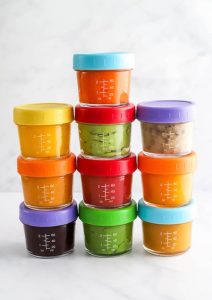
Single Vegetables vs. Mixes
There’s no right or wrong answer when it comes to offering single vegetables or vegetable mixes. Some parents prefer to start with single vegetables to identify any potential allergies. Others like to introduce combinations right away. Whichever approach you choose, start with a single serving of a new vegetable and wait a few days before introducing another new food. This way, you can monitor your baby for any allergic reactions.
Preparing Homemade Vegetable Purees
Making your own baby food allows you to control exactly what goes into your baby first vegetable puree. Here’s a basic guide:
- Wash and chop vegetables: Wash and chop your chosen vegetable into small pieces.
- Steaming or boiling: Steam or boil the vegetables until soft. You can also use a steamer basket over a pot of boiling water.
- Pureeing: Once the vegetables are soft, puree them in a blender or food processor until smooth. Add a little breast milk, formula, or water to achieve the desired consistency.
Tips for Freezing Homemade Purees
If you’re making a large batch of puree, you can easily freeze it in portions for later use. Here are some tips:
- Portion and freeze: Let the puree cool completely, then portion it into ice cube trays or small freezer-safe containers.
- Label and store: Label each portion with the date and vegetable type. Store in the freezer for up to 3 months.

Choosing Commercial Vegetable Purees
There are many commercially prepared baby food options available. Here’s what to look for when selecting a baby first vegetable puree:
- Look for the “Stage 1” label: This indicates the puree is suitable for babies starting solids.
- Choose single-ingredient purees: This is especially helpful if you’re following a single-food introduction approach.
- Read the label carefully: Avoid purees with added sugars, salt, or artificial flavors.
Feeding Your Baby Vegetable Purees
Once you have your vegetable puree ready, it’s time to feed your baby! Here are some tips for a positive feeding experience:
- Start with a small amount: Offer just a spoonful or two of puree at first.
- Use a soft-tipped spoon: A soft-tipped spoon is gentle on your baby’s gums.
- Let your baby take the lead: Allow your baby to explore the taste and texture of the puree at their own pace.
- Watch for cues: Pay attention to your baby’s signals. If they turn away or fuss, they may be finished eating. Remember: Every Baby Develops at Their Own Pace
The key takeaway is to be patient and relaxed when introducing your baby to first vegetables. Every baby develops at their own pace. Some babies may take to new flavors right away, while others may need more time to adjust.
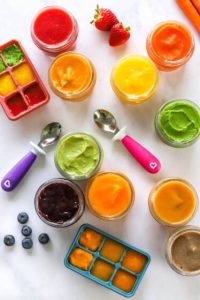
Making Mealtime Fun and Positive
Introducing solid foods is a journey of discovery for both you and your baby. Here are some ways to make mealtime a fun and positive experience:
- Create a calm and relaxed environment. Avoid distractions like loud noises or screens.
- Get down to your baby’s level. Sit facing your baby and make eye contact.
- Use a silly spoon or colorful bib. A little novelty can make mealtime more engaging.
- Narrate your actions. Describe the taste and texture of the puree as you feed your baby.
- Sing songs or make funny faces. Keep the mood light and playful.
Beyond the Spoon: Exploring Self-Feeding
As your baby develops their hand-eye coordination, they may show interest in self-feeding. Here are some safe ways to encourage this exploration:
- Mashed banana or avocado slices: These soft foods are easy for babies to pick up and gum.
- Steamed veggie sticks: Larger, soft veggie sticks like steamed broccoli florets can be fun for babies to gnaw on.
- Mesh feeders: Fill a mesh feeder with pureed fruits or vegetables. This allows babies to suck and taste the food without choking.
Remember: Always supervise your baby closely during self-feeding to prevent choking hazards.
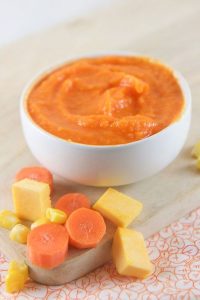
Common Questions about Introducing Vegetables
Here are some answers to frequently asked questions about introducing vegetables to babies:
- What if my baby rejects the puree? Don’t be discouraged! It can take several tries for babies to warm up to new flavors and textures. Be patient and offer the puree again in a few days.
- Can I add spices or herbs to the puree? It’s generally safe to introduce herbs and spices once your baby is around 6 months old. Start with small amounts and watch for any allergic reactions.
- How much puree should I offer my baby? Every baby has a different appetite. Start with a small amount and let your baby guide you. Signs of fullness include turning away from the spoon or fussing.
Conclusion
Introducing first vegetables is an exciting step in your baby’s development. By following these tips and creating a positive mealtime experience, you can help your baby develop a healthy relationship with food. Remember, there’s no rush. Be patient, have fun, and enjoy this special time with your little one.
